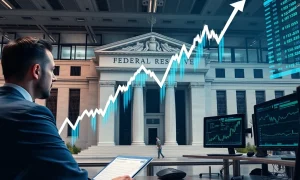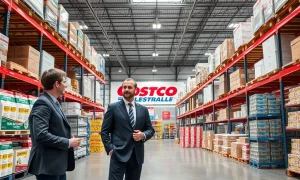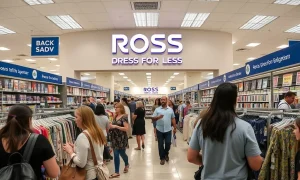The start of a new academic year traditionally signals a significant boost for retailers. Families across the nation prepare for classrooms. They purchase essential supplies, clothing, and technology. This annual ritual drives considerable economic activity. However, this year presents unique challenges. Rising inflation and persistent tariffs are casting a long shadow. These factors directly impact household budgets. Consequently, **back-to-school spending** faces unprecedented pressure. This shift in consumer behavior could significantly test the broader stock market. Businesses and investors are watching closely. They assess the potential ripple effects. Understanding these dynamics is crucial for economic insight.
Understanding the Economic Headwinds on Back-to-School Spending
Consumers currently face a difficult economic landscape. Inflation has pushed up prices for everyday goods. Families see costs rise at grocery stores and gas pumps. This reduces their **disposable income**. Furthermore, tariffs on imported goods add another layer of expense. These duties increase the price of many products. Items like electronics and apparel become more expensive. Retailers often pass these increased costs to shoppers. Therefore, families have less money available for discretionary purchases. **Back-to-school spending** becomes a key area for budget cuts. Parents must prioritize essentials over non-essentials. This cautious approach reshapes the retail environment.
How Inflation Erodes Purchasing Power for Families
Inflation directly impacts family budgets. The cost of living has surged. Parents notice higher prices for food and utilities. This means less money for school supplies. For instance, a backpack might cost 15% more than last year. Notebooks and pens also see price increases. Families must make difficult choices. They often opt for cheaper alternatives. Some delay purchases altogether. This reduction in purchasing power affects all income brackets. Low-income families feel the pinch most severely. They struggle to afford even basic necessities. Consequently, **back-to-school spending** patterns shift dramatically. Many parents reuse items from previous years. Others hunt for sales more aggressively.
The Tariff Impact on School Supplies and Apparel
Tariffs represent an additional financial burden. These taxes apply to imported goods. Many school supplies and clothing items come from overseas. For example, a significant portion of electronics originates from China. Tariffs on these products increase their retail price. This extra cost is often absorbed by consumers. Retailers find it hard to avoid these duties. They pass them on to maintain profit margins. Consequently, items like laptops, tablets, and even certain clothing brands become pricier. Families purchasing these goods face higher bills. This impacts the overall budget for **back-to-school spending**. It forces parents to reconsider premium brands. They might choose store-brand alternatives. This affects both quality and variety in the market.
Retailers Grapple with Shifting Back-to-School Spending Habits
Retailers face significant challenges this season. They must navigate reduced consumer demand. At the same time, their own operational costs are rising. Increased inventory costs stem from tariffs. Higher shipping expenses also play a role. Retailers must decide whether to absorb these costs. Alternatively, they pass them on to customers. This decision directly impacts their competitiveness. Many are offering more promotions. They hope to attract budget-conscious shoppers. However, aggressive discounting can erode profit margins. Stores are also adjusting their inventory. They focus on essential items. Less emphasis is placed on premium or discretionary products. The shift in **back-to-school spending** forces a strategic rethink. Retailers adapt their marketing and pricing strategies. They aim to capture market share in a tougher environment.
The Stock Market’s Reaction to Retail Performance
Consumer spending drives a large part of the economy. Therefore, any slowdown directly impacts corporate earnings. The **retail sector** is particularly sensitive. Weak **back-to-school spending** reports can signal broader economic weakness. This often leads to **investor apprehension**. Stock prices of major retailers might decline. Companies like Target, Walmart, and Amazon often see their shares react. Furthermore, suppliers to these retailers also feel the pressure. Their stock values could also fall. Investors interpret these trends carefully. They look for signs of a recession. A prolonged period of weak consumer spending could trigger a wider market correction. The stock market reflects these expectations. It often reacts quickly to economic data. Therefore, the back-to-school season serves as a critical barometer.
Broader Economic Implications and Investor Sentiment
The challenges to **back-to-school spending** extend beyond retail. They influence overall economic sentiment. Businesses might reduce their investment plans. This happens if they anticipate weaker consumer demand. Job growth could also slow down. Furthermore, central banks monitor these trends closely. They consider inflation and consumer behavior. This data informs their **monetary policy** decisions. Investors, consequently, become more cautious. They might shift funds from growth stocks to safer assets. This risk aversion can lead to market volatility. Uncertainty becomes a dominant theme. The interconnectedness of the economy means one sector’s struggle affects many others. Therefore, a subdued back-to-school season has far-reaching consequences. It influences investor confidence in the broader market.
Inflation and tariffs are indeed creating headwinds. They significantly impact **back-to-school spending** this year. Families face tough budgeting decisions. Retailers must adapt their strategies. This ripple effect extends to the stock market. Investors are closely monitoring retail performance. They use it as an indicator of economic health. The coming months will reveal the full extent of these pressures. Navigating this complex economic environment requires careful planning. Both consumers and businesses must adjust. Understanding these trends is vital for everyone. It shapes our economic future.
Frequently Asked Questions (FAQs)
Q1: How do inflation and tariffs specifically affect back-to-school spending?
A1: Inflation raises the cost of goods and services overall. This reduces family purchasing power. Tariffs are taxes on imported goods. They increase the price of many school supplies and apparel items. Both factors make essential back-to-school purchases more expensive for families.
Q2: What impact does reduced back-to-school spending have on the stock market?
A2: Reduced **back-to-school spending** can signal weaker consumer demand. This directly impacts the revenue and profits of retail companies. Investors often react by selling shares of these companies. This can lead to stock price declines. It might also signal broader economic slowdowns, affecting overall market sentiment.
Q3: Are all families equally affected by these economic pressures?
A3: No, the impact is often disproportionate. Low-income families typically feel the effects most severely. They have less disposable income to begin with. Rising prices for essentials like food and gas leave them with fewer funds for school supplies. Middle-income families also face significant budgeting challenges.
Q4: How are retailers responding to the changes in consumer spending habits?
A4: Retailers are adapting in several ways. They are offering more promotions and discounts. Some focus on stocking essential, value-priced items. They might also adjust their inventory to reflect changing demand. This helps them manage costs and attract budget-conscious shoppers.
Q5: What long-term effects could this trend have on the economy?
A5: A sustained period of reduced consumer spending could slow economic growth. Businesses might delay investments or hiring. Central banks could adjust monetary policy in response. This could lead to a more cautious economic outlook. It affects various sectors beyond just retail.
Q6: What can consumers do to manage increased back-to-school costs?
A6: Consumers can employ several strategies to mitigate rising costs.
- Start shopping early: This allows for finding sales and comparing prices effectively.
- Compare prices: Check different retailers, both online and in-store.
- Reuse items: Utilize school supplies and clothing from previous years if still functional.
- Opt for store-brand products: Generic brands often provide similar quality at a lower price point.
- Budget carefully: Prioritize essential items before considering discretionary purchases.
These approaches help families stretch their **back-to-school spending** further.

















